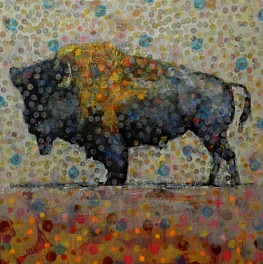BIOGRAPHY

Les Thomas, who was born in British Columbia in 1962, has long recognized painting as a language in its own right, and its diversity, in terms of poetic and conceptual messages, exhibited by each individual picture. Les' education is indicative of his dedication to his chosen profession as an artist. He earned his Bachelor of Fine Arts at the University College in London, England. After returning to Canada he attended the University of Calgary, gaining his Master of Fine Arts.
Thomas sifts through a wide variety of visual sources for the imagery in his work. The influence of his view of painting as a very noble activity is combined with his acknowledgement that it can be inventive and enjoyable (for both the artist and the viewer). The other major influence is culture, in its broadest terms, including all aspects of our everyday life.
Les Thomas' dynamic wax & oil animal paintings allow him to play with the relationship between culture and nature. The special encaustic wax finish that he applies, Les explains, "may very well pertain to memory, and the manner in which we hold visual experiences within the capacities for recollection. Think of the last time you encountered a bear on the roadside, or craned your neck to watch a mountain goat or sheep on a steep and rocky slope."
"My intention with each of my animal paintings is to forge some kind of amicable relationship between the patterns and abstract paint application, and a particular animal image. In this sense, the image is not merely a pretext for a painting. It actually provides the impetus for how the entire surface is to be treated."
Les Thomas has received many awards for his work, been featured in several publications, and has his paintings in public and private collections in Canada, the U.S., the U.K. and Germany.
Artist’s Statement
My paintings might best be described as a hybrid of realism and pop art. To begin with, and almost exclusively, the subjects of my paintings are sourced from printed material such as magazines and newspapers, as well as from my own photographs and films. So the images I choose to paint have already been translated from their primary world models to that of a two-dimensional representation. And it is this aspect of printed imagery that catches my attention, as opposed to what a particular image might represent in terms of social, political, or symbolic associations. Those concerns, as Zizek suggests, are woven into all cultural activities, so I assume they are woven into mine. Consequently, it has become amongst my artistic beliefs that I have the freedom to enlist a wide variety of imagery in my artistic endeavors, such as wildlife, landscapes, portraits and human figures. Basically the subject matter of historical and traditional painting practices. However, the difference with my culling such categories is narrow in the sense that I only want subjects that support the sub-narrative expressions I seek. My intentions are to avoid making any claims or tell stories.
Once selected, an image will undergo further translation as I manipulate an appearance for the role it will play in a particular painting. To some degree, I suppose two-dimensional printed material offers me an interpretive head start in this creative process. However, and as much as I do bend the particulars of any image, it is a chief concern of mine that the images I render possess a certain degree of optical fidelity, that is something embodied in a relatively detailed depiction, or one impressionistic in nature, or a reduced expression, like an outline or silhouette. So the images I picture can fall short of strict likenesses, but they do have to possess some kind of fundamental visual allegiance with their real world counterparts. However, and having emphasized this pragmatic component, it should be evident that making appearances is not the desired point of arrival for my art.
The realism, or representational diction I practice, is immersed in a world of patterns and paint applications intended to draw attention to the painted surface, that is the painting as a physical object (the reason I prefer my paintings unframed). “In” the painting, an image is juxtaposed or harmoniously intertwined with the corporeal. Conversely, the factuality of the objects’ surface and paint as a material substance, are coupled with the fiction resulting from a medium having been manipulated to picture something. I suppose I aim to have my art make literal the paradox of the practice itself, in that traditional painting typically provided the viewer with something to look out or into and beyond its surface, whereas Modernism liberated painting from conventional depiction and sought to emphasize the substance of paint and thus the flat painted surface. Simplistically explained here; paintings are either a window or a door. In reality, they are both.
